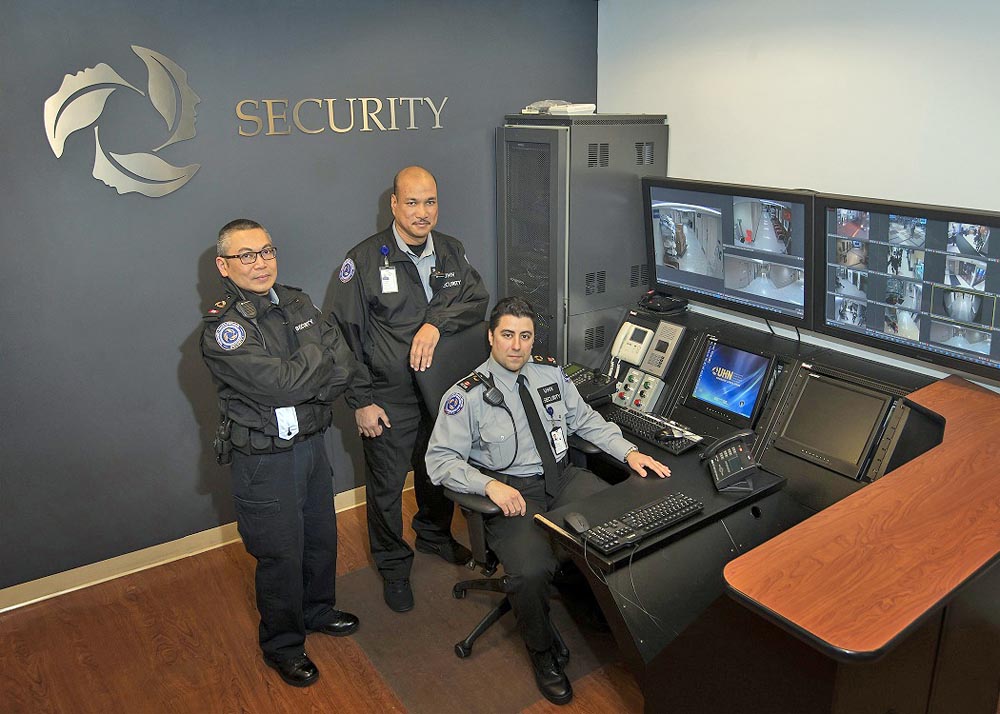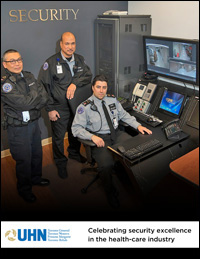Celebrating security excellence in the health-care industry
By Kate Lysakowski
It is shocking to think that as little as 30 years ago, just about anyone interested in exploring a career in Canadian security could apply for the job with no experience, credentials or certification required.
According to Todd Milne, the Director of Security Operations for the University Health Network (UHN), “Security guards used to walk around with keys and a radio; there actually were no standards or licensing per se.” In Milne’s 30-year tenure with the UHN, which is responsible for four principal health facilities in and around the Greater Toronto Area (GTA), including the Toronto General, Toronto Western, Princess Margaret and Toronto Rehabilitation Institute, he has admittedly seen a dramatic change in the way health-care security functions, and his direct contribution to its successful operation earned Milne the title of Security Director of the Year for 2015.
Milne accepted his position in 2003, bringing more than 30 years of industry experience including serving as the owner of Madison Security Inc. and as an auxiliary member police constable for Toronto Police Services. In his present capacity, he is responsible for overseeing security programs for over 17,000 members of the organization as well as collaborating with senior leaders to achieve corporate objectives. The vision of the security sector within the UHN is to be the most “innovative and strategic leaders of security and safety in the health-care industry,” and Milne has demonstrated his commitment to that vision by his support and promotion of the profession through his involvement with groups such as the International Association for Healthcare Security and Safety (IAHSS). As the Commission Chair, Milne is responsible for overseeing the credential programs and developing strategy to meet certification, as well as ensuring the content and quality of the examinations is sufficient for measuring student capabilities prior to entering the field.
There are five criteria or “strategic pillars” within the security sector of the UHN that contributes to their ongoing pursuit for excellence: Firstly, and most importantly according to the UHN, is human resources; “the success of any organization is predicated on the strength and ability of the team.” Extensive and ongoing training initiatives are mandatory for staff and volunteers to mitigate potential security risks to themselves as well as patients and visitors. Secondly, enhancing the leadership structure within the security sector by increasing the number of supervisory positions and requiring greater qualifications and experience accelerates professional and personal growth and improves staff retention and development.
The third pillar is education; it is essential to consistently revisit current programs and implement new learning mediums to cater to changing security risks. The risk and mitigation UHN pillar is essential because it ensures there is a knowledge, awareness and appreciation of the risks associated with the organization, which are based on several factors including sector and location. Lastly, the systems and technology effort is one that is currently receiving particular attention, and is a pillar of which Milne is especially proud.
The UHN’s integrated Security Communications Centre will effectively create a central hub for what is now operated through separate off-site switchboards for each health-care facility. It is this latest technology effort that will be the primary focus over the next five years, ensuring all external phone calls and dispatches for each facility will be addressed from one, single location. Another exciting technological endeavour, Milne explains, is the standardization of software, which makes it possible to carry one access card to move through each sector of the building with the same capabilities of carrying four.
“Technology has come a long way,” Milne said. “UHN began with minimal camera coverage; we now have 1,100, which is a massive leap from where we were a few years ago.” All of the UHN-affiliated health-care facilities have transitioned from analog to IP with plans to expand their resources. The Security program uses a “security-in-depth” model that can easily be described as layers within the facility that limits access to particular areas. “As one moves deeper into the property, the greater the level of security. If one (security) system fails, another exists to sustain it.” The dramatic increase in the number as well as the quality of video cameras used throughout all of the UHN facilities is advantageous in supporting this model. Since the target incident response time is three minutes, “it is beneficial to have eyes everywhere,” Milne explained.
When asked about his recently being named the Security Director of the Year by Canadian Security Magazine, a particular honor because candidates are accepted from every security industry in the country, Milne humbly stated, “I have a great deal of respect for all of my colleagues and the industry at large … I am flattered that they took the time to document my services.” The public recognition of Milne’s commitment to security and safety within the health-care community, both for the UHN and the industry at large, proves that “security is an integral part to how we provide health care” and Milne is making every effort to ensure that it is state of the art.







